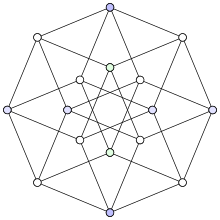In mathematics, particularly in algebraic topology, the n-skeleton of a topological space X presented as a simplicial complex (resp. CW complex) refers to the subspace Xn that is the union of the simplices of X (resp. cells of X) of dimensions m ≤ n. In other words, given an inductive definition of a complex, the n-skeleton is obtained by stopping at the n-th step.

These subspaces increase with n. The 0-skeleton is a discrete space, and the 1-skeleton a topological graph. The skeletons of a space are used in obstruction theory, to construct spectral sequences by means of filtrations, and generally to make inductive arguments. They are particularly important when X has infinite dimension, in the sense that the Xn do not become constant as n → ∞.
In geometry
editIn geometry, a k-skeleton of n-polytope P (functionally represented as skelk(P)) consists of all i-polytope elements of dimension up to k.[1]
For example:
- skel0(cube) = 8 vertices
- skel1(cube) = 8 vertices, 12 edges
- skel2(cube) = 8 vertices, 12 edges, 6 square faces
For simplicial sets
editThe above definition of the skeleton of a simplicial complex is a particular case of the notion of skeleton of a simplicial set. Briefly speaking, a simplicial set can be described by a collection of sets , together with face and degeneracy maps between them satisfying a number of equations. The idea of the n-skeleton is to first discard the sets with and then to complete the collection of the with to the "smallest possible" simplicial set so that the resulting simplicial set contains no non-degenerate simplices in degrees .
More precisely, the restriction functor
has a left adjoint, denoted .[2] (The notations are comparable with the one of image functors for sheaves.) The n-skeleton of some simplicial set is defined as
Coskeleton
editMoreover, has a right adjoint . The n-coskeleton is defined as
For example, the 0-skeleton of K is the constant simplicial set defined by . The 0-coskeleton is given by the Cech nerve
(The boundary and degeneracy morphisms are given by various projections and diagonal embeddings, respectively.)
The above constructions work for more general categories (instead of sets) as well, provided that the category has fiber products. The coskeleton is needed to define the concept of hypercovering in homotopical algebra and algebraic geometry.[3]
References
edit- ^ Peter McMullen, Egon Schulte, Abstract Regular Polytopes, Cambridge University Press, 2002. ISBN 0-521-81496-0 (Page 29)
- ^ Goerss, P. G.; Jardine, J. F. (1999), Simplicial Homotopy Theory, Progress in Mathematics, vol. 174, Basel, Boston, Berlin: Birkhäuser, ISBN 978-3-7643-6064-1, section IV.3.2
- ^ Artin, Michael; Mazur, Barry (1969), Etale homotopy, Lecture Notes in Mathematics, No. 100, Berlin, New York: Springer-Verlag